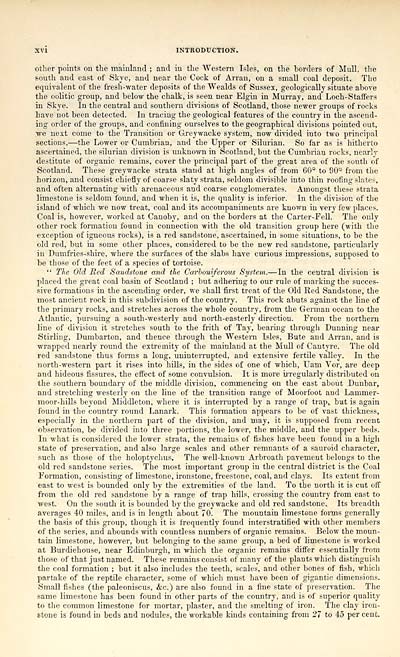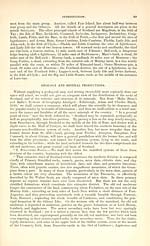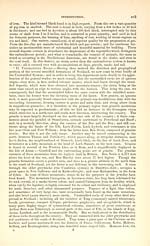Download files
Complete book:
Individual page:
Thumbnail gallery: Grid view | List view

XVI INTRODUCTION.
other points on the mainland ; and in the Western Isles, on the borders of Mull, the
south and east of Skye, and near the Cock of Arraii, on a small coal deposit. The
equivalent of the fresh-water deposits of the Wealds of Sussex, geologically situate above
the oolitic group, and below the chalk, is seen near Elgin in Murray, and Loch-Staffers
in Skye. In the central and southern divisions of Scotland, those newer groups of rocks
have not been detected. In tracing the geological features of the country in the ascend-
ing order of the groups, and confining ourselves to the geographical divisions pointed out,
we nest come to the Transition or Greywacke system, now divided into two principal
sections, — the Lower or Cumbrian, and the Upper or Silurian. So far as is hitherto
ascertained, the silurian division is unknown in Scotland, but the Cumbrian rocks, nearly
destitute of organic remains, cover the principal part of the great area of the south of
Scotland. These greywacke strata stand at high angles of from 60' to 90 Q from the
horizon, and consist chiefly of coarse slaty strata, seldom divisible into thin roofing slates,
and often alternating with arenaceous and coarse conglomerates. Amongst these strata
limestone is seldom found, and when it is, the quality is inferior. In the division of the
island of which we now treat, coal and its accompaniments are known in very few places.
Coal is, however, worked at Canoby, and on the borders at the Carter-Fell. The only
other rock formation found in connection with the old transition group here (with the
exception of igneous rocks), is a red sandstone, ascertained, in some situations, to be the
old red, but in some other places, considered to be the new red sandstone, particularly
in Dumfries-shire, where the surfaces of the slabs have curious impressions, supposed to
be those of the feet of a species of tortoise.
" The Old Bed Sandstone and the Carboniferous System. — In the central division is
placed the great coal basin of Scotland ; but adhering to our rule of marking the succes-
sive formations in the ascending order, we shall first treat of the Old Red Sandstone, the
most ancient rock in this subdivision of the country. This rock abuts against the line of
the primary rocks, and stretches across the whole country, from the German ocean to the
Atlantic, pursuing a south-westerly and north-easterly direction. From the northern
line of division it stretches south to the frith of Tay, bearing through Dunning near
Stirling, Dumbarton, and thence through the Western Isles, Bute and Arran, and is
wrapped nearly round the extremity of the mainland at the Mull of Cantyre. The old
red sandstone thus forms a long, uninterrupted, and extensive fertile valley. In the
north-western part it rises into hills, in the sides of one of which, Uam Vor, are deep
and hideous fissures, the effect of some convulsion. It is more irregularly distributed on
the southern boundary of the middle division, commencing on the east about Dunbar,
and stretching westerly on the line of the transition range of Moorfoot and Lammer-
moor-hills beyond Middleton, where it is interrupted by a range of trap, but is again
found in the country round Lanark. This formation appears to be of vast thickness,
especially in the northern part of the division, and may, it is supposed from recent
observation, be divided into three portions, the lower, the middle, and the upper beds.
In what is considered the lower strata, the remains of fishes have been found in a high
state of preservation, and also large scales and other remnants of a sauroid character,
such as those of the holoptj'chus. The well-known Arbroath pavement belongs to the
old red sandstone series. The most important group in the central district is the Coal
Formation, consisting of limestone, ironstone, freestone, coal, and cla} T s. Its extent from
east to west is bounded only by the extremities of the land. To the north it is cut off
from the old red sandstone by a range of trap hills, crossing the country from east to
west. On the south it is bounded by the greywacke and old red sandstone. Its breadth
averages 40 miles, and is in length about 70. The mountain limestone forms generally
the basis of this group, though it is frequently found interstratified with other members
of the series, and abounds with countless numbers of organic remains. Below the moun-
tain limestone, however, but belonging to the same group, a bed of limestone is worked
at Burdiehouse, near Edinburgh, in which the organic remains differ essentially from
those of that just named. These remains consist of many of the plants which distinguish
the coal formation ; but it also includes the teeth, scales, and other bones of fish, which
partake of the reptile character, some of which must have been of gigantic dimensions.
Small fishes (the paleoniscus, &c.) are also found in a fine state of preservation. The
same limestone has been found in other parts of the country, and is of superior quality
to the common limestone for mortar, plaster, and the smelting of iron. The clay iron-
stone is found in beds and nodules, the workable kinds containing from 27 to 45 per cent.
other points on the mainland ; and in the Western Isles, on the borders of Mull, the
south and east of Skye, and near the Cock of Arraii, on a small coal deposit. The
equivalent of the fresh-water deposits of the Wealds of Sussex, geologically situate above
the oolitic group, and below the chalk, is seen near Elgin in Murray, and Loch-Staffers
in Skye. In the central and southern divisions of Scotland, those newer groups of rocks
have not been detected. In tracing the geological features of the country in the ascend-
ing order of the groups, and confining ourselves to the geographical divisions pointed out,
we nest come to the Transition or Greywacke system, now divided into two principal
sections, — the Lower or Cumbrian, and the Upper or Silurian. So far as is hitherto
ascertained, the silurian division is unknown in Scotland, but the Cumbrian rocks, nearly
destitute of organic remains, cover the principal part of the great area of the south of
Scotland. These greywacke strata stand at high angles of from 60' to 90 Q from the
horizon, and consist chiefly of coarse slaty strata, seldom divisible into thin roofing slates,
and often alternating with arenaceous and coarse conglomerates. Amongst these strata
limestone is seldom found, and when it is, the quality is inferior. In the division of the
island of which we now treat, coal and its accompaniments are known in very few places.
Coal is, however, worked at Canoby, and on the borders at the Carter-Fell. The only
other rock formation found in connection with the old transition group here (with the
exception of igneous rocks), is a red sandstone, ascertained, in some situations, to be the
old red, but in some other places, considered to be the new red sandstone, particularly
in Dumfries-shire, where the surfaces of the slabs have curious impressions, supposed to
be those of the feet of a species of tortoise.
" The Old Bed Sandstone and the Carboniferous System. — In the central division is
placed the great coal basin of Scotland ; but adhering to our rule of marking the succes-
sive formations in the ascending order, we shall first treat of the Old Red Sandstone, the
most ancient rock in this subdivision of the country. This rock abuts against the line of
the primary rocks, and stretches across the whole country, from the German ocean to the
Atlantic, pursuing a south-westerly and north-easterly direction. From the northern
line of division it stretches south to the frith of Tay, bearing through Dunning near
Stirling, Dumbarton, and thence through the Western Isles, Bute and Arran, and is
wrapped nearly round the extremity of the mainland at the Mull of Cantyre. The old
red sandstone thus forms a long, uninterrupted, and extensive fertile valley. In the
north-western part it rises into hills, in the sides of one of which, Uam Vor, are deep
and hideous fissures, the effect of some convulsion. It is more irregularly distributed on
the southern boundary of the middle division, commencing on the east about Dunbar,
and stretching westerly on the line of the transition range of Moorfoot and Lammer-
moor-hills beyond Middleton, where it is interrupted by a range of trap, but is again
found in the country round Lanark. This formation appears to be of vast thickness,
especially in the northern part of the division, and may, it is supposed from recent
observation, be divided into three portions, the lower, the middle, and the upper beds.
In what is considered the lower strata, the remains of fishes have been found in a high
state of preservation, and also large scales and other remnants of a sauroid character,
such as those of the holoptj'chus. The well-known Arbroath pavement belongs to the
old red sandstone series. The most important group in the central district is the Coal
Formation, consisting of limestone, ironstone, freestone, coal, and cla} T s. Its extent from
east to west is bounded only by the extremities of the land. To the north it is cut off
from the old red sandstone by a range of trap hills, crossing the country from east to
west. On the south it is bounded by the greywacke and old red sandstone. Its breadth
averages 40 miles, and is in length about 70. The mountain limestone forms generally
the basis of this group, though it is frequently found interstratified with other members
of the series, and abounds with countless numbers of organic remains. Below the moun-
tain limestone, however, but belonging to the same group, a bed of limestone is worked
at Burdiehouse, near Edinburgh, in which the organic remains differ essentially from
those of that just named. These remains consist of many of the plants which distinguish
the coal formation ; but it also includes the teeth, scales, and other bones of fish, which
partake of the reptile character, some of which must have been of gigantic dimensions.
Small fishes (the paleoniscus, &c.) are also found in a fine state of preservation. The
same limestone has been found in other parts of the country, and is of superior quality
to the common limestone for mortar, plaster, and the smelting of iron. The clay iron-
stone is found in beds and nodules, the workable kinds containing from 27 to 45 per cent.
Set display mode to: Large image | Transcription
Images and transcriptions on this page, including medium image downloads, may be used under the Creative Commons Attribution 4.0 International Licence unless otherwise stated. ![]()
| Gazetteers of Scotland, 1803-1901 > Topographical, statistical, and historical gazetteer of Scotland > Volume 1 > (28) Page xvi |
|---|
| Permanent URL | https://digital.nls.uk/97437882 |
|---|
| Description | Volume first. A-H. |
|---|---|
| Attribution and copyright: |
|

